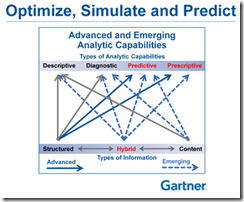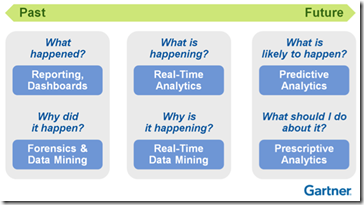 Big Data and Analytics is a vast and growing field whose concept and context boundaries continue to expand. In this Part 4, we explore alternative perspectives other views to expand our own perspective.
Big Data and Analytics is a vast and growing field whose concept and context boundaries continue to expand. In this Part 4, we explore alternative perspectives other views to expand our own perspective.
There is significant room for other perspectives on Big Data and Analytics. Through alternative lenses with diverse perspective, those who are newly exposed and just starting to explore Big Data and Analytics will gain depth and breadth to their understanding.
Big Data and Analytics – Other Views
There are three contextual perspectives that I have found timely, valuable, and worth sharing. Each in its own way supports my vision and mission for a common analytics platform that allows people to focus on extracting value, not building one-off systems. The systems that today claim to be platforms require way too much effort to deploy. The true democratized value of Big Data and Analytics must come in a system as simple to use and apply as Survey Monkey is to use, or Google Analytics is to apply. Configuration, customization, and frankly – the software, must get out of the user’s way, and allow them to focus on achieving their Big Data and Analytics objective. Too much software is focused on forcing users to learn and know the software – which is off point.
The following perspectives will help to shape this new platform yet to come – as they look at the problem to solve in context of what the user, analyst or decision maker are trying to achieve in terms of outcome.
QuadDirect – Data Value Chain
QuadDirect points out that you can have all the data in the world, but owning or accessing this asset alone will not bring success. They have identified five elements in a value chain to move from owning data to taking action. In their success story on Demand Insight QuadDirect makes a good point that precise measurement is useful, only if you know why, where to look, and how much to analyze. In terms of getting to an outcome from Big Data and Analytics, their five element data value chain has these elements:
Data – the raw numeric or alphanumeric values associated with specific measured events.
Information – the data collected into tables or other organized areas so that they can be used in a meaningful way.
Analytics – information that has been sorted through, using a range of algorithms and programs, so that aggregated trends or results are visible.
Insights – key learning from the analytics, identified in terms of meaningful business conclusions that can be drawn.
Actions – based on insights, business actions are taken to correct or exploit the results of all the work done in the data/information/analytics/insights value chain so far.
Accenture – Analytics Value Chain
Accenture points out that using quantitative data to form decisions and drive outcomes is a critical competitive advantage. Accenture concluded that a proper solution to extract insight included formal methods to capture knowledge and create value out of available streams of social content, audio, image and video data. They point out that tools and technology advances are critical to this process as data is proliferating at an exponential rate in both type and volume. The Accenture data value chain uses process to connect tools to people. And, it describes analysis through statistical science as “methods” which extracts “insight” that is applicable throughout decision-making through final outcomes. Accenture further points out that most technology focuses attention on the early part of the value chain, leaving much opportunity for downstream solution development.
Gartner – Analytics Capabilities Chain
At their Symposium ITXPO in Orlando Florida October 2012, Gartner made several presentations that emphasized new developments Big Data and Analytics have in terms of Information Technology for a variety of industries. They shared an interesting value chain concept that is less linear and more organic where data, content and hybrid combinations serve a chain of potential outcomes. They group these outcomes in terms of understanding the past (descriptive and diagnostic), and exploring the future (predictive and prescriptive).
In terms questions to ask when looking into history through the data record, Gartner points out a series of questions. And likewise, in terms of using real-time content, combined with structured data, Gartner suggests that a new set of questions can be answered through statistical computations. That creates the following outline hierarchy of questions from Gartner
- Descriptive
- What happened?
- What is happening?
- Diagnostic
- Why did it happen?
- What are the key relationships?
- Predictive
- What will happen?
- What if?
- How risky is it?
- Prescriptive
- What should happen?
- What is the best option?
- How can I optimize?
Gartner also points out that the End User’s questions will change, as innovation around Big Data and Analytics continues to reach commercial and industrial markets. These questions will change for the entire business ecosystem of development partners, suppliers, vendors, channel partners and differentiated customer segments.
Where To From Here?
In this series we’ve explored the importance of understanding the difference between Big Data and Analytics. Big Data we learned exists in historical containers or silos while at the same time is constantly growing and evolving. Analytics we learned is also evolving but is much less mature. New Analytics platforms are yet to come that will be easy-to-use and deploy to create value from the ongoing growth of Big Data. Some key takeaways:
- It’s not owning or having access to big data that is valuable; it is the analysis of big data.
- Analytics platforms are on the horizon, and will change the questions we ask.
- Vast new opportunities for technology advances in applied statistics on rolling series of real-time data exist.
- There are not enough trained people in this space to fill the need in every business functional domain.
- Entrepreneurial ideas must have a Big Data and Analytics component – as a consumer or creator of value.
Image credit Accenture Analytics Value Chain, Accenture. Garner Analytics Value Chain, adapted from notes. Gartner presentation Applications 2020 – The Impact of Mobile, Social, Cloud and Big Data, Gartner Symposium ITXPO, October 2012. Clock perspective image: Gilderic Photography via photopin cc













[…] 7. Big Data and Analytics, Other Perspectives by Andrew Stein […]
[…] Big Data and Analytics is a vast field perfect for a common analytics platform that allows people to focus on extracting value, not building one-off systems (From Archives: Big Data And Analytics, Other Perspectives Worth A Look – Part 4 […]
[…] Big Data and Analytics is a vast field perfect for a common analytics platform that allows people to focus on extracting value, not building one-off systems (From Archives: Big Data And Analytics, Other Perspectives Worth A Look – Part 4 […]